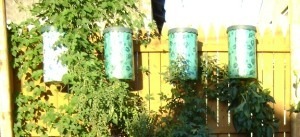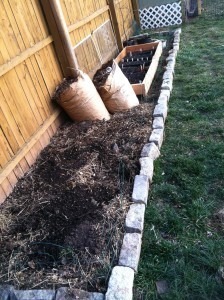This is the first of three articles geared toward helping a suburban or even an urban dweller become more food self sufficient. It doesn’t take a lot of space to grow food but it does take a different type of thinking than the traditional garden. I’ll break down my experiences into skills every square foot gardener should have… but first, a few caveats. One, this writeup is not comprehensive, I wont go into great detail and Ill take for granted each reader has some basic gardening skill. Two, this is based upon my experience in suburban NJ, Im not a master gardener by any stretch of the imagination, so don’t count this as accurate advice for someone in a different climate with a very different soil type.
Choosing your crops wisely
Some plants are well suited from square foot gardening and others aren’t. Try to choose plant varieties that  lend themselves to high yields in small areas. Great choices are leaf lettuce (as opposed to head lettuce, both grow quickly but leaf lettuce plants will continue to produce if they stay picked), pole beans (as opposed to bush beans because they can be grown vertically for a higher yield), and sunflowers for aesthetics (they are unique, look nice, and produce edible seeds). Plants to avoid are corn (uses up a lot of space for a limited yield and needs a lot of water), pumpkins (same reasons as corn), and strawberries (produce well but only after several years of sending out runners). Keep in mind, you may be planting in pots or even in buckets so plants with a shallow root system and limited water requirements is important.
lend themselves to high yields in small areas. Great choices are leaf lettuce (as opposed to head lettuce, both grow quickly but leaf lettuce plants will continue to produce if they stay picked), pole beans (as opposed to bush beans because they can be grown vertically for a higher yield), and sunflowers for aesthetics (they are unique, look nice, and produce edible seeds). Plants to avoid are corn (uses up a lot of space for a limited yield and needs a lot of water), pumpkins (same reasons as corn), and strawberries (produce well but only after several years of sending out runners). Keep in mind, you may be planting in pots or even in buckets so plants with a shallow root system and limited water requirements is important.
Start early
Since youre limited by a smaller amount of plantable space, its best to start things early and try to extent  your growing season. Hot boxes are a great way to heat up your soil and planters for seedlings. A simple wood frame or a set of shelves and some plastic sheeting can extend your growing season quite a bit. I have made my boxes out of left over lumber from a home improvement job and the glass panes from my storm doors.
your growing season. Hot boxes are a great way to heat up your soil and planters for seedlings. A simple wood frame or a set of shelves and some plastic sheeting can extend your growing season quite a bit. I have made my boxes out of left over lumber from a home improvement job and the glass panes from my storm doors.
Pots, planters, and hanging buckets
Growing vegetables in planters is a great way to get more yield out of your smaller space… and to grow in  places that normally couldn’t be used to grow at all. Some of the things Ive used are flower pots, wooden boxes, and buckets. With a wooden frame and some hooks, I was able to turn some planters (and eventually buckets since the commercial planters only lasted only a few years… click here for a link to the hanging planters) into hanging planters that grew my tomatoes
places that normally couldn’t be used to grow at all. Some of the things Ive used are flower pots, wooden boxes, and buckets. With a wooden frame and some hooks, I was able to turn some planters (and eventually buckets since the commercial planters only lasted only a few years… click here for a link to the hanging planters) into hanging planters that grew my tomatoes  and cucumbers downward. I have grown lettuce and bush beans in relatively shallow planters using regular potting soil (and adding compost half way through the growing season). One thing about container planting that is both a blessing and a pain, is the soil is changed yearly (atleast partially). If a crop fails, the soil can be changed completely the following season (or later in the same season for a fast growing crop) without having to improve the soil over time like in a standard garden. The problems are, disposing of the used soil if you have no yard and buying new soil each year to replace old.
and cucumbers downward. I have grown lettuce and bush beans in relatively shallow planters using regular potting soil (and adding compost half way through the growing season). One thing about container planting that is both a blessing and a pain, is the soil is changed yearly (atleast partially). If a crop fails, the soil can be changed completely the following season (or later in the same season for a fast growing crop) without having to improve the soil over time like in a standard garden. The problems are, disposing of the used soil if you have no yard and buying new soil each year to replace old.
Small raised beds
A small raised (or a bed separated from your yard) can be used the same as a regular gardening plot. It is a permanent fixture of the garden so the soil can be improved over time by tilling to add in new organic matter or using permaculture techniques….the result is a more consistently productive soil. I grow a 3 foot wide garden bordering my  property on both sides… both sides have fences but the plants still get good full day sun. The narrower garden allows for plenty of yard and easier access to vegetables without having to step over one plant to get to another, I simply lean in and pick what I need. Also, I can use a a composter to get all the organic matter I need for garden of this size… I simply add kitchen scraps, leaves, dirt, grass clippings, etc and when its ready, I add the composed material to my soil. I don’t recycle my leaves with the rest of my neighborhood… I use them as mulch and ultimately as compost when they decompose.
property on both sides… both sides have fences but the plants still get good full day sun. The narrower garden allows for plenty of yard and easier access to vegetables without having to step over one plant to get to another, I simply lean in and pick what I need. Also, I can use a a composter to get all the organic matter I need for garden of this size… I simply add kitchen scraps, leaves, dirt, grass clippings, etc and when its ready, I add the composed material to my soil. I don’t recycle my leaves with the rest of my neighborhood… I use them as mulch and ultimately as compost when they decompose.
Tools of the trade
Much of what you will need for square foot gardening is found in your local home depot or  Walmart….although I prefer to give my business to local co-ops (we can help the economy by buying local and American wherever possible… but that’s a totally different topic). Aside from the basic tools like a shovel, rake, etc, you may want to look into purchasing a small tiller. They are easy to run don’t take up much shed space. I have a ryobi model (click here for info) that allows me to change heads from a weed trimmer to tiller to a hedge trimmer. I like it because it takes up less space in my shed and its one engine for multiple garden tools (anyone who maintains gas engines and winterizes them yearly can appreciate that).
Walmart….although I prefer to give my business to local co-ops (we can help the economy by buying local and American wherever possible… but that’s a totally different topic). Aside from the basic tools like a shovel, rake, etc, you may want to look into purchasing a small tiller. They are easy to run don’t take up much shed space. I have a ryobi model (click here for info) that allows me to change heads from a weed trimmer to tiller to a hedge trimmer. I like it because it takes up less space in my shed and its one engine for multiple garden tools (anyone who maintains gas engines and winterizes them yearly can appreciate that).
Watering
Watering can be done relatively easily with a small garden plot. I use an old gutter attached to my shed and  a barrel to catch the rain water. Its in the back of my property behind some other things so its out of the way and doesn’t draw attention (in some locations it’s a violation to catch rain water… again another story). This cuts down on my water bill and makes filling watering cans fast and convenient. Use mulch… a lot of it! The more mulch used in raised bed, the less water your plants will require….except your plants in pots and other planters. Planters have a tendency to dry out very quickly so make sure you water them thoroughly everyday.
a barrel to catch the rain water. Its in the back of my property behind some other things so its out of the way and doesn’t draw attention (in some locations it’s a violation to catch rain water… again another story). This cuts down on my water bill and makes filling watering cans fast and convenient. Use mulch… a lot of it! The more mulch used in raised bed, the less water your plants will require….except your plants in pots and other planters. Planters have a tendency to dry out very quickly so make sure you water them thoroughly everyday.
This should give you a few ideas of how to approach your gardening in an suburban or urban area. My closing advice would be three things…1. Don’t expect to become self reliant square foot gardening, the best you can hope for is to grow a portion of your food (or some specialty foods that are hard to come by) but you will still be making trips to the grocery store. Even with canning and intensive practices, you will find the limited yields are inadequate for being self sufficient. 2. START… you don’t know what you can grow or how much fun it can be until you try your hand at gardening. Don’t be afraid of making too many mistakes either… learn as you go and you’ll find your garden (and nature in general) is pretty resilient to rooky mistakes. 3. Look for more advice from your local coop, agricultural extension, or gardening groups. They will have much better advice for your particular climate and soil type… as well as advice on what crops may grow well in your area.









